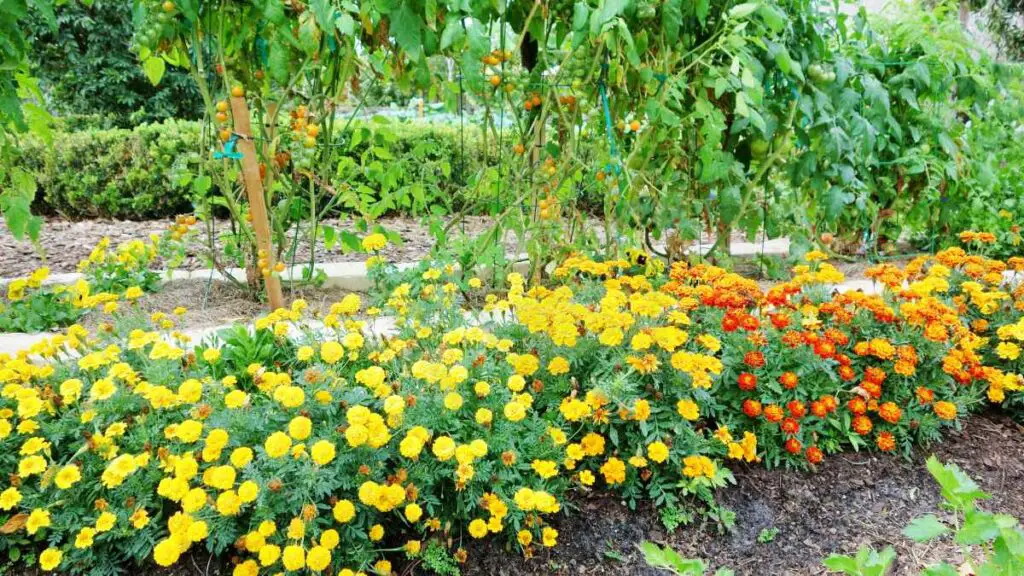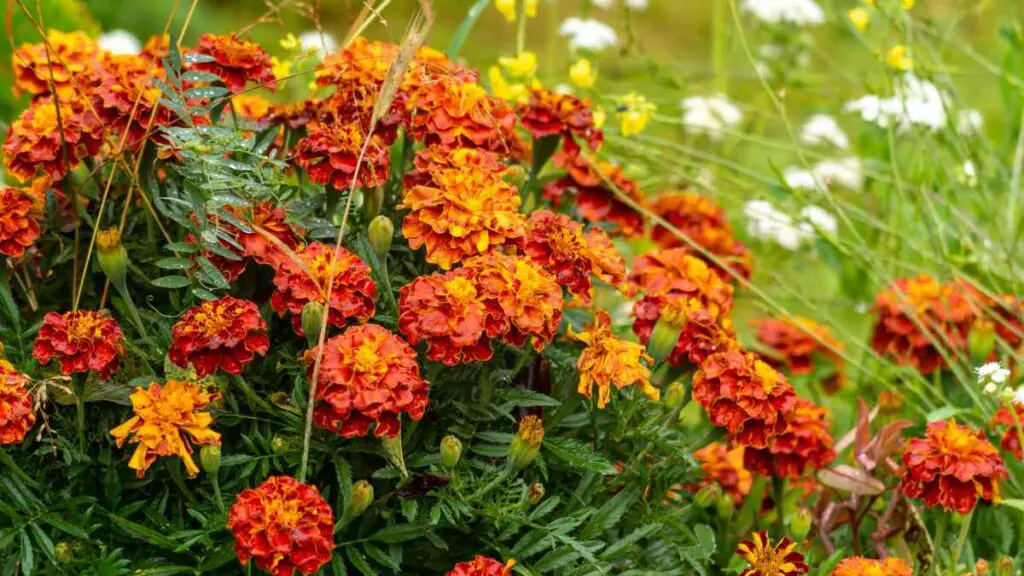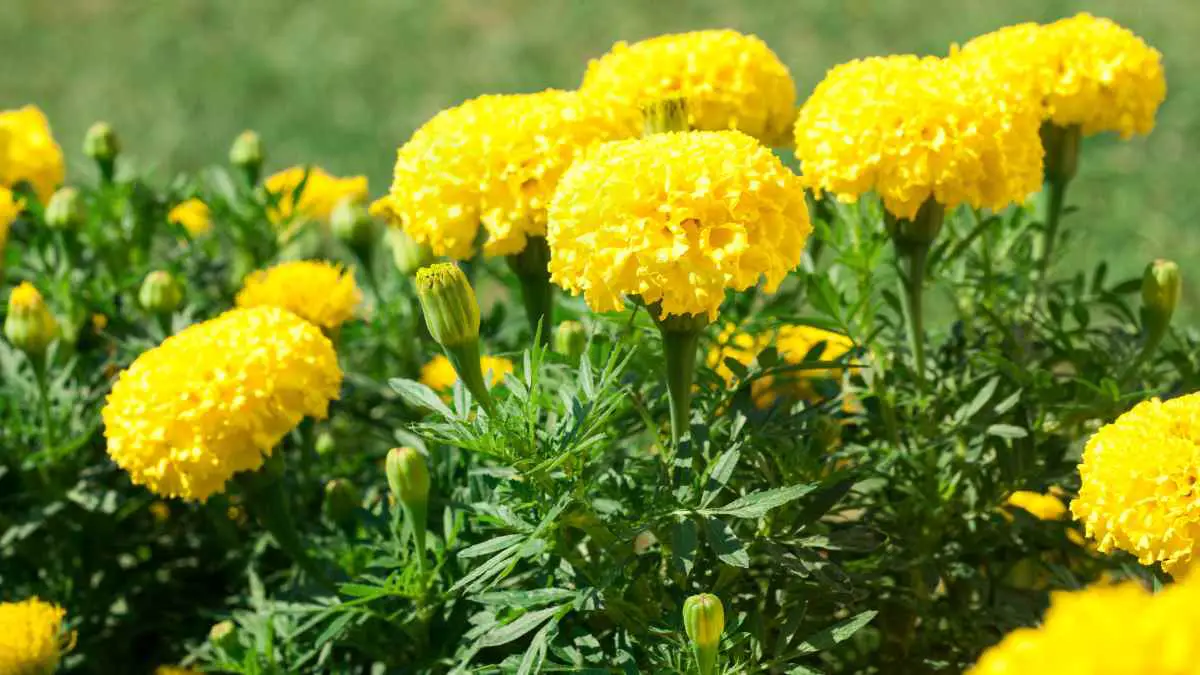Did you know that the marigold flower plant is not only a vibrant addition to your garden but also offers numerous benefits beyond its beauty? From natural pest repellent properties to its usefulness in traditional medicine, the marigold flower plant is a versatile and valuable asset for any gardener. Whether you are a seasoned gardener or just starting out, discover why the marigold flower plant deserves a prime spot in your garden.
Key Takeaways
- Plant marigold flowers in well-draining soil under full sun for optimal growth and blooming.
- Sow marigold seeds, a yellow flower, directly into the garden after the last frost date in your area.
- Water marigolds consistently, ensuring the soil remains moist but not waterlogged.
- To propagate marigolds, collect seeds from spent flowers and sow them in prepared soil.
- Keep an eye out for common pests like aphids and diseases like powdery mildew, addressing them promptly.
- Explore different species of marigolds such as French, African, and signet for varied colors and sizes in your garden.
Understanding Marigold Basics
Marigold Varieties
African, French, and signet marigolds are the primary varieties with distinct characteristics. African marigolds boast large blooms and a strong scent. French marigolds, favorites species, come in various colors like gold, orange, and red. Signet marigolds have small, delicate flowers and a pleasant fragrance.
Each type of marigold varies in size and growth habits. African marigolds can reach heights of up to three feet, while French marigolds are more compact, growing up to one foot tall. Signet marigolds are usually smaller in size compared to the other varieties.
Ideal Locations
The best locations for planting marigolds are those that receive full sunshine for at least six hours a day. Insufficient sunlight can lead to leggy growth and fewer blooms. Marigolds thrive in warm climates and require well-drained soil to prevent waterlogging.
Different locations impact the growth and blooming of marigolds significantly. Inadequate sunlight may result in stunted growth and reduced flowering. Planting marigolds in shaded areas can hinder their ability to produce vibrant blooms.
Essential Soil
Moderately fertile, well-drained soil is crucial for healthy marigold growth. Marigolds prefer soil with good drainage to prevent root rot or fungal diseases. The soil quality directly influences the overall health and development of these vibrant flowering plants.
Marigolds thrive in specific soil conditions that provide optimal growth opportunities. Sandy loam or loamy soils with a slightly acidic to neutral pH level are ideal for cultivating healthy marigold plants. Ensuring proper soil drainage is essential for preventing waterlogged conditions that can harm the roots.
Best Time for Planting

Seasonal Guide
Plant marigolds in spring for vibrant summer blooms. Sow seeds after the last frost date.
How to Plant Marigolds
Seed Sowing
Planting marigolds from seeds is a simple and rewarding process. Begin by preparing the soil in early spring, ensuring it is well-drained and fertile. Sow the seeds about half an inch deep and keep them moist until germination. Marigold seeds typically germinate within 4-14 days, depending on the variety and environmental conditions. Once they sprout, thin out the seedlings to give each plant enough space to thrive.
- Pros:
- Cost-effective way to grow marigolds
- Allows for a wide selection of marigold varieties
- Cons:
- Requires patience as seeds take time to germinate
- May need protection from birds or pests during germination
Transplanting Tips
When your marigold seedlings have grown a few inches tall, it's time to transplant them into the garden. Before transplanting, water the plants thoroughly to reduce stress during the process. Choose a sunny spot with well-draining soil for optimal growth. Gently remove the seedlings from their pots, being careful not to damage the roots, and plant them at the same depth as they were in the containers.
Effective transplanting tips include gradually acclimating seedlings to outdoor conditions before planting them directly in the garden. This helps minimize shock and increases their chances of survival. Water newly transplanted marigolds regularly, especially during dry periods, to establish strong root systems.
- Water seedlings before transplanting.
- Choose a sunny location with well-draining soil.
- Acclimate seedlings gradually to outdoor conditions.
- Plant at the same depth as they were in containers.
- Water regularly after transplanting.
Proper Care for Marigolds

Watering Guidelines
Marigold plants require a consistent watering schedule to thrive. Establish a routine that keeps the soil moist but not waterlogged. Understanding the importance of proper watering is crucial for the health of your marigolds. Avoid overwatering as it can lead to root rot and underwatering, causing wilting.
To ensure your marigold plants receive adequate moisture, consider factors like weather conditions and soil drainage. Check the soil regularly by inserting your finger into the top layer. If it feels dry, it's time to water. Maintaining a balance in watering helps prevent stress on the plants.
Fertilizing Needs
Identifying the specific fertilizing requirements of marigolds is essential for their growth. Choose a balanced fertilizer with equal parts nitrogen, phosphorus, and potassium. Marigolds benefit from fertilizers rich in organic matter that promote blooming.
When feeding your marigold plants, consider using a slow-release fertilizer or liquid fertilizer diluted in water. Fertilize your marigolds every 3-4 weeks during the growing season for optimal results. Avoid over-fertilizing as it can lead to excessive foliage growth at the expense of flowers.
Pruning Tips
Pruning plays a vital role in ensuring healthy growth and abundant blooming in marigold plants. Regularly removing spent flowers encourages new blooms to develop, prolonging the flowering period. Focus on deadheading faded blooms to maintain plant vigor.
When pruning marigolds, target areas with dead or damaged foliage to promote air circulation and prevent disease spread. Use clean gardening shears to make precise cuts above leaf nodes or branching points. Proper pruning techniques help shape the plant and stimulate new growth.
Propagating Marigolds
Seed Collection
Collecting seeds from mature marigold flowers is a simple process. Wait for the flower heads to dry on the plant before harvesting them. Once dry, carefully pluck the seeds from the flower heads and store them in a cool, dry place. Properly stored marigold seeds can remain viable for planting for up to five years. Seed collection is crucial for preserving specific marigold varieties and ensuring a continuous supply of these vibrant flowers in your garden.
Division Methods
Dividing and propagating marigold plants can be done through various methods. One common technique is dividing the plant at its base using a sharp knife or shears. By separating the root system into sections, you can create new marigold plants that will continue to bloom beautifully. Dividing marigold plants not only helps in expanding your garden but also promotes healthier growth by allowing each division to thrive independently.
Managing Diseases and Pests
Common Issues
Marigold plants are susceptible to various diseases and pests that can hinder their growth. One common issue faced by marigolds is powdery mildew, a fungal disease that manifests as white powdery spots on the leaves. This disease thrives in humid conditions, leading to stunted growth and yellowing of foliage.
Other common problems include root rot, caused by overwatering, which results in wilting and decay of roots. Marigolds can fall prey to pests like aphids and spider mites, causing damage to the plant by sucking sap from the leaves and stems. These issues can weaken the plant's overall health and vitality.
To address these challenges, it is crucial to promptly identify the symptoms of each problem. For instance, if you notice white powdery patches on the leaves, it indicates a powdery mildew infection. Similarly, wilting or yellowing leaves may signal root rot. By recognizing these signs early on, you can take swift action to mitigate the damage.
Prevention Tips
Preventing diseases and pests is key to ensuring the longevity of your marigold plants. To safeguard your plants, start by implementing proper watering practices. Avoid overwatering, as excessive moisture can create an ideal environment for diseases like powdery mildew and root rot to thrive. Instead, water your marigolds at the base of the plant to keep the foliage dry.
Furthermore, promote good air circulation around your marigold plants by spacing them adequately apart. Adequate airflow helps reduce humidity levels and minimizes the risk of fungal diseases. Consider planting marigolds in well-draining soil enriched with organic matter to support healthy root development and prevent waterlogging.
Another proactive measure is to regularly inspect your marigold plants for any signs of pests or diseases. Remove any affected leaves or flowers immediately to prevent further spread. You can also introduce beneficial insects like ladybugs or lacewings to naturally control pest populations in your garden.
Different Types of Marigolds
French Marigolds
French marigolds, known for their compact size and vibrant colors, are a popular choice for garden borders. These marigolds boast double blooms in shades of orange, yellow, and red. Growing French marigolds requires full sun and well-drained soil. They are ideal for containers and edging due to their neat growth habit.
To care for French marigolds, ensure they receive regular watering without waterlogging the soil. Deadheading spent blooms promotes continuous flowering. These marigolds are resistant to many pests, making them low-maintenance plants. Incorporating French marigolds in gardens adds a splash of color and attracts beneficial insects like ladybugs.
- Benefits:
- Compact size suitable for borders
- Vibrant double blooms in various colors
American/African Marigolds
American and African marigolds differ in their size and flower type, with American varieties having smaller flowers compared to the larger African blooms. American marigolds thrive in cooler climates while African marigolds prefer hot, sunny conditions. Both types require well-drained soil and regular deadheading for optimal growth.
American marigolds are often used in vegetable gardens to deter pests due to their strong scent, while African marigolds are prized for their use in garlands and decorations during cultural celebrations. Understanding these distinctions helps gardeners choose the right variety based on their climate and purpose.
- Cultural Significance:
- American marigolds used as pest deterrents
- African marigolds favored for cultural celebrations
Using Marigolds in Gardens
Aesthetic Value
Marigold flowers add charm to gardens with their vibrant colors and unique flowerheads. The bright hues of marigolds create a visually appealing landscape that catches the eye. Their blossoms come in shades of yellow, orange, and red, enhancing the overall beauty of any garden setting.
Explore the aesthetic appeal of marigolds by planting them in borders, containers, or mixed beds. Their large flowers make them stand out among other plants, bringing a pop of color to any corner of the garden. Marigolds bloom profusely throughout the growing season, ensuring a constant display of their beauty.
Companion Planting
Discover the benefits of companion planting marigolds alongside vegetables and herbs in your garden. Marigolds act as natural pest deterrents, protecting neighboring plants from harmful insects. Their strong aroma repels pests like aphids and nematodes, reducing the need for chemical pesticides.
Incorporate marigolds into your garden to attract beneficial insects such as ladybugs and lacewings. These insects feed on common garden pests, promoting a healthy ecosystem within your garden. By planting marigolds strategically among your crops, you can naturally control pest populations while supporting biodiversity.
Final Remarks
You now have a solid foundation on marigold planting, care, and propagation. By following the best practices discussed, you can ensure healthy and vibrant marigold blooms in your garden. Remember to plant them at the right time, provide proper care, and watch out for any signs of diseases or pests. Experiment with different types of marigolds to add variety and color to your outdoor space.
Incorporate marigolds into your garden design to not only enhance its aesthetic appeal but also to benefit from their natural pest-repelling properties. Whether you're a seasoned gardener or just starting out, marigolds are a versatile and rewarding addition to any garden. Get your hands dirty, enjoy the process, and watch your marigolds flourish!
Frequently Asked Questions
Can I plant marigold flowers indoors?
Yes, you can plant marigold flowers indoors as long as they receive plenty of sunlight and are placed in well-draining soil. Be sure to water them moderately and provide adequate air circulation to prevent diseases.
How often should I water my marigold plants?
Water your marigold plants thoroughly when the top inch of soil feels dry to the touch. Depending on the weather conditions, this may range from once or twice a week. Avoid overwatering to prevent root rot.
What is the best time to propagate marigolds?
The best time to propagate marigolds is in the spring when the plants are actively growing. You can propagate them through seeds or by dividing mature plants. Ensure the new plants have enough warmth and sunlight for healthy growth.
How do I protect my marigolds from pests?
To protect your marigolds from pests, regularly inspect the plants for any signs of infestation. Use organic pest control methods like neem oil spray or insecticidal soap. Encourage beneficial insects like ladybugs that prey on common marigold pests.
Are there specific companion plants that go well with marigolds?
Marigolds make excellent companion plants for vegetables like tomatoes, peppers, and eggplants due to their ability to repel certain pests. They also pair well with herbs such as basil and oregano. Planting them together can help improve overall garden health.
Image Source: Paid image from CANVA


